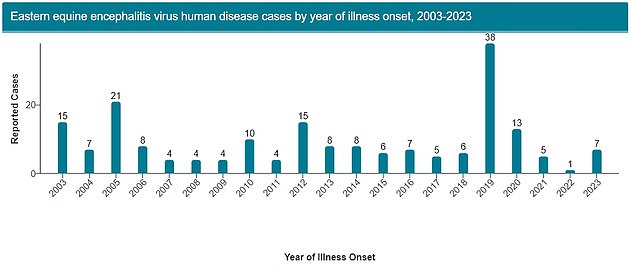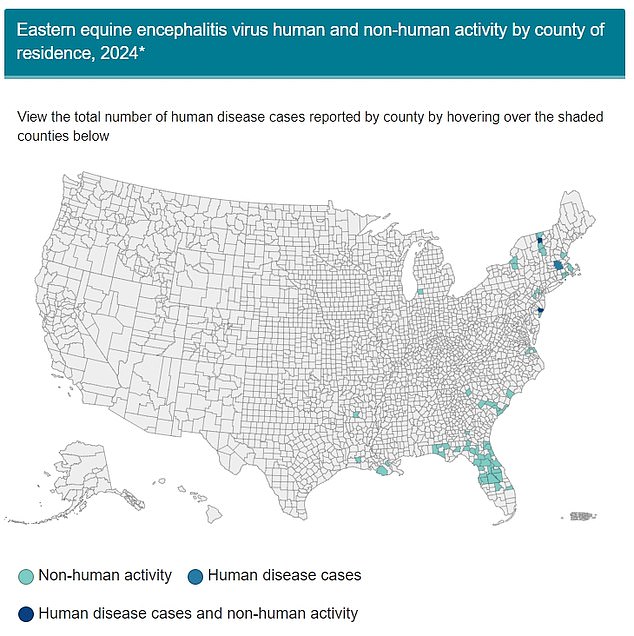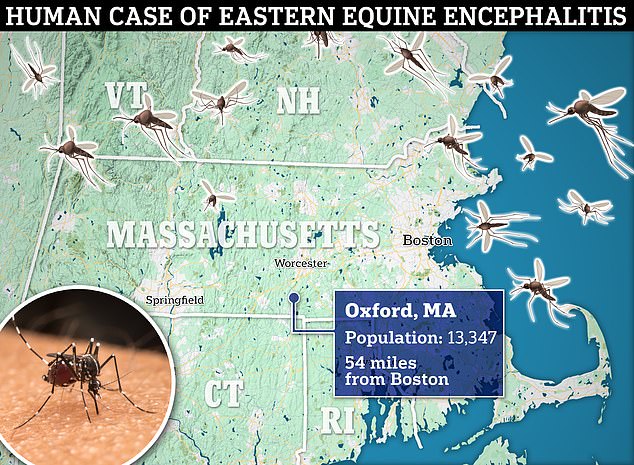More than half of Massachusetts is at high or critical risk from a deadly mosquito-borne virus.
Warnings have been issued to ten of the state’s 14 counties about an elevated presence of Eastern Equine Encephalitis (EEE), also called “Triple E.”
A curfew was approved last week in Oxford County, home to 13,300 residents and about 50 miles from Boston, after a resident became the first human to contract the untreatable disease in the state in four years. The 80-year-old man has been hospitalized in critical condition with EEE.
Now, the city of Plymouth (home to 60,800 residents about 40 miles from Boston) will close outdoor recreation areas from dusk to dawn every day because a horse in the city has tested positive for the virus.
The curfews and closures come amid heightened fears of mosquito-borne diseases, as Dr. Anthony Fauci was hospitalized for six days this month after being infected with the potentially deadly West Nile virus.
And officials hope the rules will encourage people to stay indoors during peak mosquito hours and reduce exposure to infected insects.
Triple E causes fever and brain inflammation and can lead to seizures and coma.
One third of people infected with EEE die, and those who recover are often left with lifelong physical and mental difficulties.
The city of Plymouth announced On Friday, all public parks and fields would be closed from dusk, which falls around 8 p.m., until dawn, which is approximately 5:30 a.m.
Officials say the curfew is “in response to the HIGH risk status of EEE in Plymouth.”
‘Sports leagues and other organizations using public parks and fields will be prohibited from continuing outdoor activities after dark.’
While the EEE-positive horse prompted the high status, EEE-infected mosquitoes have also been identified in Plymouth, Barnstable, and Essex counties.
The Plymouth County Mosquito Control Project is continuously spraying requested neighborhoods and will be spraying the ground at all public parks, fields and schools this week.
The dusk curfew in Oxford County is only a recommendation, not a rule.
But the local school district will enforce it, meaning after-school programs and sports could be canceled, ended early or moved indoors — something many parents, students and athletes disagree with.
Nearly 1,000 Oxford residents have signed an online petition to keep sports grounds open.
The state Department of Public Health announced over the weekend that it plans to conduct aerial mosquito spraying in Plymouth and Worcester counties as 10 Massachusetts communities have been elevated to high or critical risk for EEE.
Symptoms of EEE usually begin four to 10 days after being bitten by an infected mosquito, according to the CDC.
Most infected people have no symptoms, but those who develop severe cases will experience fever, chills, body aches and joint pain.
In mild cases, recovery takes about one to two weeks and people will likely make a full recovery if the infection does not affect the central nervous system, the CDC added.
However, people with severe cases may develop meningitis (inflammation of the brain and spinal cord) or encephalitis (inflammation of the brain).
These symptoms include fever, headache, vomiting, diarrhea, seizures, behavioral changes, drowsiness, and even coma.
There is no specific treatment for EEE, but doctors will provide supportive care to manage symptoms, such as pain relievers and hydrating fluids.


For the approximately 33 percent of people with EEE who die, death usually occurs between two and ten days after the onset of symptoms.
People who survive are left with brain damage and permanent disabilities that require long-term care. They may die within a few years after recovering from the initial infection, the CDC added.
Only a few cases of EEE are reported in the U.S. each year, and most often they occur in eastern or Gulf Coast states.
So far in 2024, two additional human cases of EEE have been reported in two other states (Vermont and New Jersey) and all three US patients have developed severe neuroinvasive cases.
A record 38 cases were reported in 2019.
Experts fear that rising temperatures, humidity and rainfall could lead to an increase in the virus.
The virus is only transmitted from mosquitoes to humans (and horses) and there is no human-to-human or animal-to-human transmission.
To protect against EEE, a public health advisory from the City of Oxford recommends wearing long sleeves and long pants, avoiding standing water, which act as breeding grounds for mosquitoes, applying insect repellent, and avoiding peak mosquito hours from dusk to dawn.

